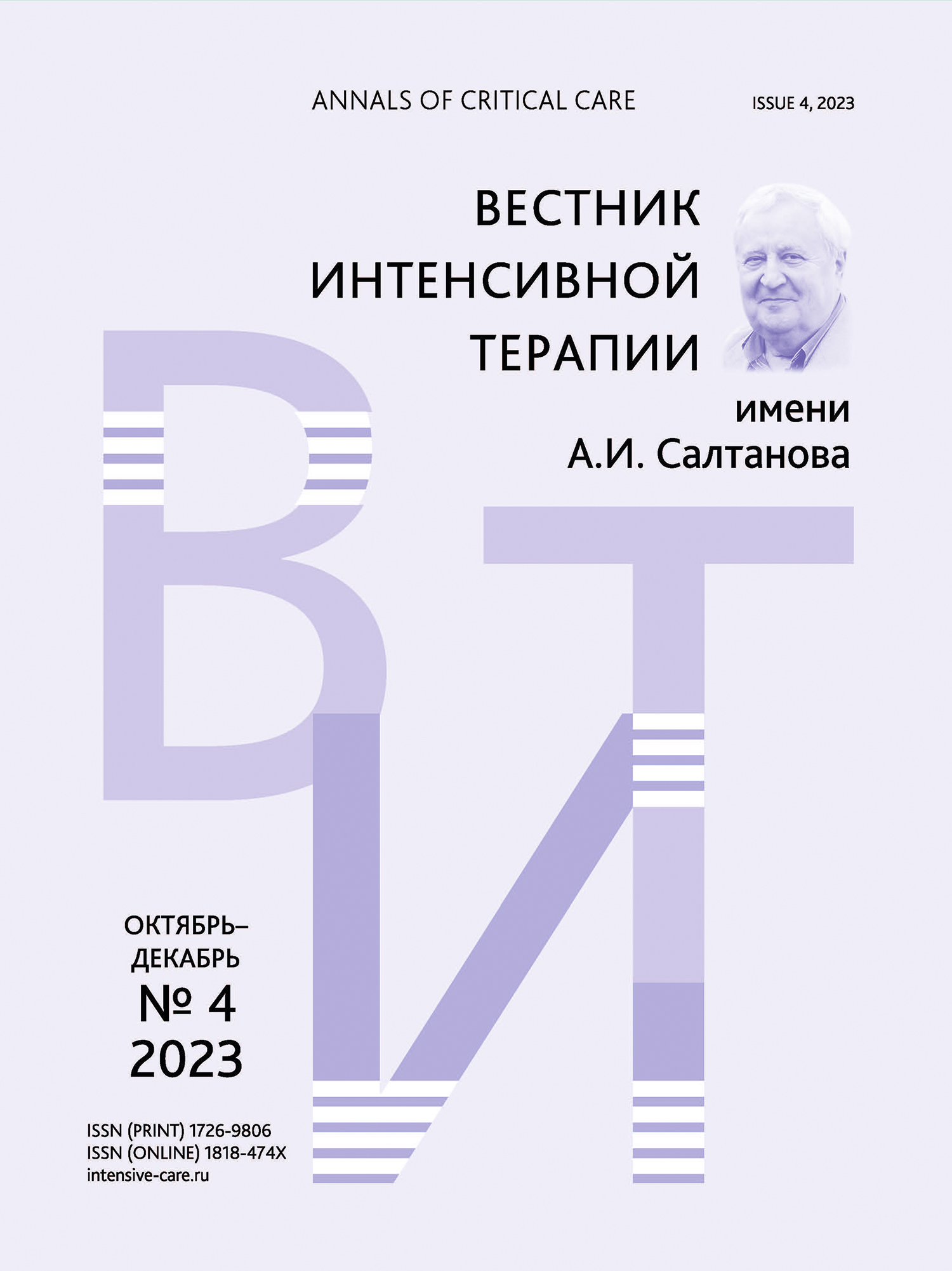Full-text of the article is available for this locale: Русский.
Abstract
INTRODUCTION: Ultrasound assessment of inferior vena cava (IVC) collapsibility is used in clinical practice to assess patients' volume status. Finding the subject in the prone position limits the ability to assess IVC collapse by the traditional method, which requires the use of alternative methods. OBJECTIVE: Conducting a comparative assessment of the IVC collapse index in healthy volunteers in the back position and in the pro position using a new acoustic window. MATERIALS AND METHODS: Ultrasound observation was performed in 25 adult healthy volunteers of both sexes. Ultrasound measurement of IVC was carried out sequentially in the position of volunteers on the back and abdomen. The mean (M) and standard deviation (SD) of the maximum and minimum IVC size. The values of the collapsing index (CI) obtained during the study are presented as a median (Me) and quartiles (Q1–Q3). Wilcoxon's nonparametric test was selected for comparative analysis (significance level accepted 0.05). RESULTS: Measurements of the diameter of the inferior vena cava obtained the following results: the average maximum and minimum vein size in volunteers in the supine position were 1.58 ± 0.37 cm and 1.30 ± 0.36 cm, respectively; in prone — 1.51 ± 0.37 cm and 1.24 ± 0.36 cm, respectively. Me (Q1–Q3) IVC-CI values (%) in volunteers in the supine and in the prone position of the voice were 16.84 (8.86–24.39) and 15.63 (10.23–24.77), respectively. Statistical analysis of the obtained results did not reveal a significant difference between CI values (p = 0.861). CONCLUSIONS: The absence of a statistically significant difference in IVC-CI values in the supine and abdominal volunteers demonstrates the possibility of using a new acoustic window to assess volume status in the clinical setting in patients in the prone position.
References
- Jarman R.D., McDermott C., Colclough A., et al. EFSUMB Clinical Practice Guidelines for Point-of-Care Ultrasound: Part One (Common Heart and Pulmonary Applications) LONG VERSION. Ultraschall in der Medizin — European Journal of Ultrasound. 2022; 44(01): e1–24. DOI: 10.1055/a-1882-5615
- Мазурок В.А., Нургалиева А.И., Баутин А.Е. и др. Объемно-компрессионная осциллометрия для оценки гемодинамики у взрослых с некоррегированными врожденными пороками сердца и легочной артериальной гипертензией. Анестезиология и реаниматология. 2022; 6: 58–67. DOI: 10.17116/anaesthesiology202206158 [Mazurok V.A., Nurgalieva A.I., Bautin A.E., et al. Volumetric compression oscillometry for hemodynamic assessment in adults with congenital heart disease and pulmonary hypertension. Russian Journal of Anesthesiology and Reanimatology. 2022; 6: 58–67. DOI: 10.17116/anaesthesiology202206158 (In Russ)]
- Старостин Д.О., Кузовлев А.Н. Роль УЗИ в диагностике объемного статуса у пациентов в критическом состоянии. Вестник интенсивной терапии им. А.И. Салтанова. 2018; 4: 42–50. DOI: 10.21320/1818-474x-2018-4-42-50 [Starostin D.O., Kuzovlev A.N. Role of ultrasound in diagnosing volume status in critically ill patients. Annals of Critical Care. 2018; 4: 42–50. DOI: 10.21320/1818-474x-2018-4-42-50 (In Russ)]
- Ilyas A., Ishtiaq W., Assad S., et al. Correlation of IVC Diameter and Collapsibility Index With Central Venous Pressure in the Assessment of Intravascular Volume in Critically Ill Patients. Cureus. 2017. DOI: 10.7759/cureus.1025
- Заболотских И.Б., Киров М.Ю., Лебединский К.М. и др. Анестезия и интенсивная терапия больных с COVID-19. Руководство Российской Федерации анестезиологов-реаниматологов. Вестник интенсивной терапии им. А.И. Салтанова. 2022; 1: 5–140. DOI: 10.21320/1818-474X-2022-1-5-140 [Zabolotskikh I.B., Kirov M.Yu., Lebedinskii K.M., et al. Anesthesia and intensive care for patients with COVID-19. Russian Federation of anesthesiologists and reanimatologists guidelines. Annals of Critical Care. 2022; 1: 5–140. DOI: 10.21320/1818-474x-2022-1-5-140 (In Russ)]
- Clarke J., Geoghegan P., McEvoy N., et al. Prone positioning improves oxygenation and lung recruitment in patients with SARS-CoV-2 acute respiratory distress syndrome; a single centre cohort study of 20 consecutive patients. BMC Research Notes. 2021; 4(1). DOI: 10.1186/s13104-020-05426-2
- Kasatkin A., Urakov A., Shchegolev A., et al. New acoustic window for assessing the inferior vena cava collapsibility in humans in the prone position. Journal of Emergency Practice and Trauma. 2023; 9(1): 76–8. DOI: 10.34172/jept.2022.30
- Hensley J., Wang H. Assessment of Volume Status During Prone Spine Surgery via a Novel Point-of-care Ultrasound Technique. Cureus. 2019. DOI: 10.7759/cureus.4601
- Hedman K., Nylander E., Henriksson J., et al. Echocardiographic Characterization of the Inferior Vena Cava in Trained and Untrained Females. Ultrasound in Medicine & Biology. 2016; 42(12): 2794–802. DOI: 10.1016/j.ultrasmedbio.2016.07.003
- Scalea T.M., Rodriguez A., Chiu W.C., et al. Focused Assessment with Sonography for Trauma (FAST). The Journal of Trauma: Injury, Infection, and Critical Care. 1999; 46(3): 466–72. DOI: 10.1097/00005373-199903000-00022
- Ajam M., Drake M., Ran R., et al. Approach to echocardiography in ARDS patients in the prone position: A systematic review. Echocardiography. 2022; 39(2): 330–8. DOI: 10.1111/echo.15294
- Шилин Д.С., Шаповалов К.Г. Гемодинамика при переводе в прон-позицию пациентов с COVID-19. Общая реаниматология. 2021; 17(3): 32–41. DOI: 10.15360/1813-9779-2021-3-32-41 [Shilin D.S., Shapovalov K.G. Hemodynamic Parameters After Prone Positioning of COVID-19 Patients. General Reanimatology. 2021; 3: 32–41. DOI: 10.15360/1813-9779-2021-3-32-41 (In Russ)]
- Fields J.M., Lee P.A., Jenq K.Y., et al. The Interrater Reliability of Inferior Vena Cava Ultrasound by Bedside Clinician Sonographers in Emergency Department Patients. Academic Emergency Medicine. 2011; 18(1): 98–101. DOI: 10.1111/j.1553-2712.2010.00952.x

This work is licensed under a Creative Commons Attribution-NonCommercial-ShareAlike 4.0 International License.
Copyright (c) 2023 Annals of Critical Care

